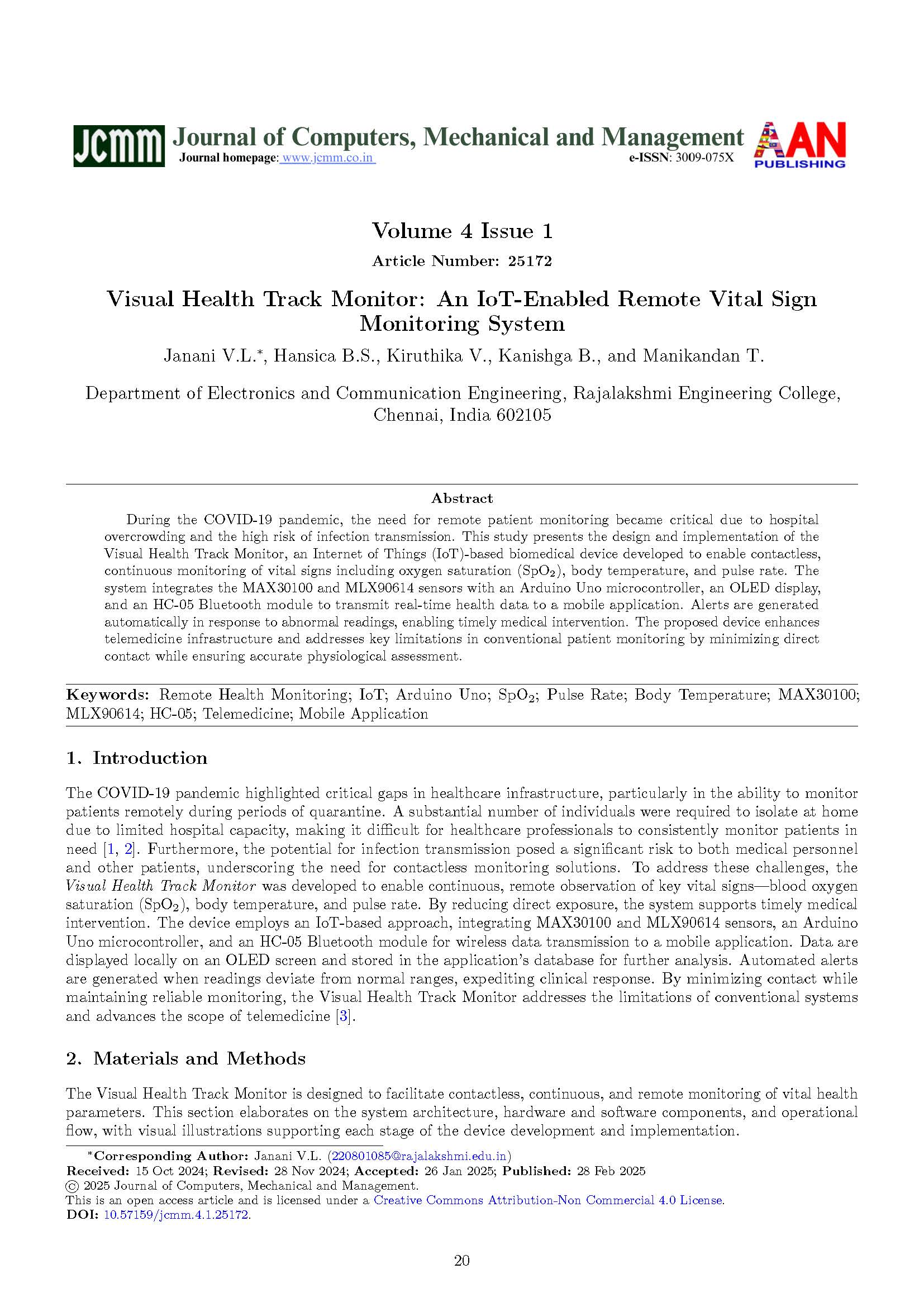Visual Health Track Monitor
An IoT-Enabled Remote Vital Sign Monitoring System
DOI:
https://doi.org/10.57159/jcmm.4.1.25172Keywords:
Remote Health Monitoring, IoT, Arduino Uno, Pulse Rate, Body Temperature, Telemedicine, Mobile ApplicationAbstract
During the COVID-19 pandemic, the need for remote patient monitoring became critical due to hospital overcrowding and the high risk of infection transmission. This study presents the design and implementation of the Visual Health Track Monitor, an Internet of Things (IoT)-based biomedical device developed to enable contactless, continuous monitoring of vital signs including oxygen saturation (SpO2), body temperature, and pulse rate. The system integrates the MAX30100 and MLX90614 sensors with an Arduino Uno microcontroller, an OLED display, and an HC-05 Bluetooth module to transmit real-time health data to a mobile application. Alerts are generated automatically in response to abnormal readings, enabling timely medical intervention. The proposed device enhances telemedicine infrastructure and addresses key limitations in conventional patient monitoring by minimizing direct contact while ensuring accurate physiological assessment.
References
J. L. Wu, A. Jayaraman, and R. D. Norris, “Wearable health monitoring systems: A review,” IEEE Transactions on Biomedical Engineering, vol. 67, no. 12, pp. 3421–3432, 2020.
A. N. Rodriguez, J. G. Chen, and J. A. Smith, “The role of IoT in healthcare: A review,” Journal of Healthcare Engineering, vol. 2019, p. Article ID 4521783, 2019.
D. L. Zhang, X. F. Li, and Q. W. Liu, “Development of a wireless health monitoring system based on IoT,” Journal of Medical Systems, vol. 43, no. 4, pp. 78–87, 2019.
A. Khalifeh, F. Mazunga, A. Nechibvute, B. M. Nyambo, et al., “Microcontroller unit-based wireless sensor network nodes: A review,” Sensors, vol. 22, no. 22, p. 8937, 2022.
J. Wan, Y. Zou, Y. Li, and J. Wang, “Reflective type blood oxygen saturation detection system based on max30100,” in 2017 International Conference on Security, Pattern Analysis, and Cybernetics (SPAC), pp. 615–619, IEEE, 2017.
Y. Yusoff, M. Morsin, Y. Saidun, and M. H. Dahri, “A study on the development of a heart rate monitoring system to determine its accuracy and effectiveness,” International Journal of Technical Vocational and Engineering Technology, vol. 5, no. 2, pp. 11–21, 2024.
S. Costanzo and A. Flores, “A non-contact integrated body-ambient temperature sensors platform to contrast COVID-19,” Electronics, vol. 9, no. 10, p. 1658, 2020.
P. W. Rusimamto, R. Harimurti, Y. Anistyasari, L. Anifah, et al., “Design and implementation of thermal body system employing thermal sensor mlx 90614 for covid-19 symptoms early detector,” in International Joint Conference on Science and Engineering (IJCSE 2020), pp. 317–321, Atlantis Press, 2020.
G. N. Mori and P. R. Swaminarayan, “Measuring iot security issues and control home lighting system by android application using arduino uno and hc-05 bluetooth module,” in Data Science and Intelligent Applications: Proceedings of ICDSIA 2020, pp. 375–382, Springer, 2020.

Downloads
Published
How to Cite
Issue
Section
License
Copyright (c) 2025 Journal of Computers, Mechanical and Management

This work is licensed under a Creative Commons Attribution-NonCommercial 4.0 International License.
The Journal of Computers, Mechanical and Management applies the CC Attribution- Non-Commercial 4.0 International License to its published articles. While retaining copyright ownership of the content, the journal permits activities such as downloading, reusing, reprinting, modifying, distributing, and copying of the articles, as long as the original authors and source are appropriately cited. Proper attribution is ensured by citing the original publication.
Accepted 2025-01-26
Published 2025-02-28

